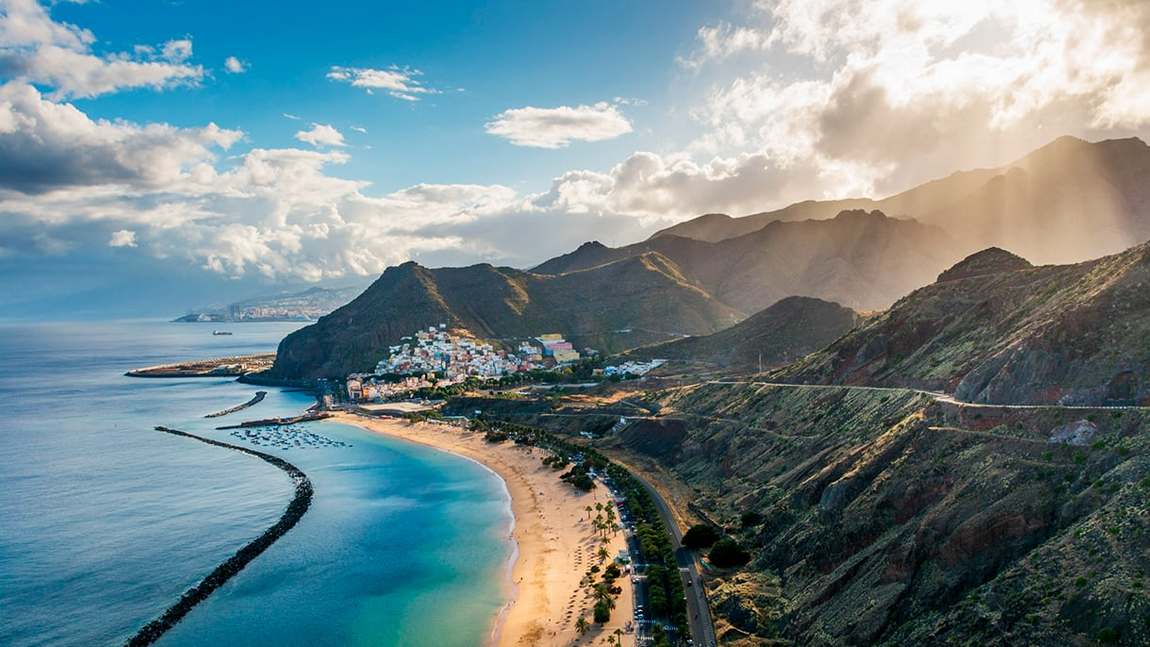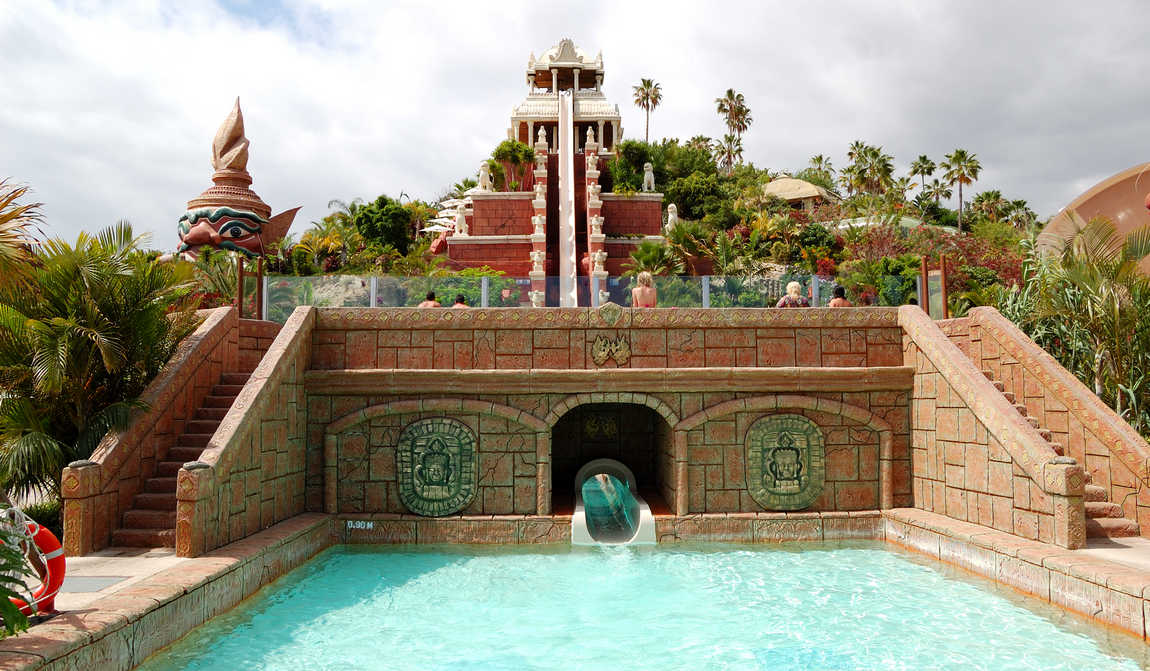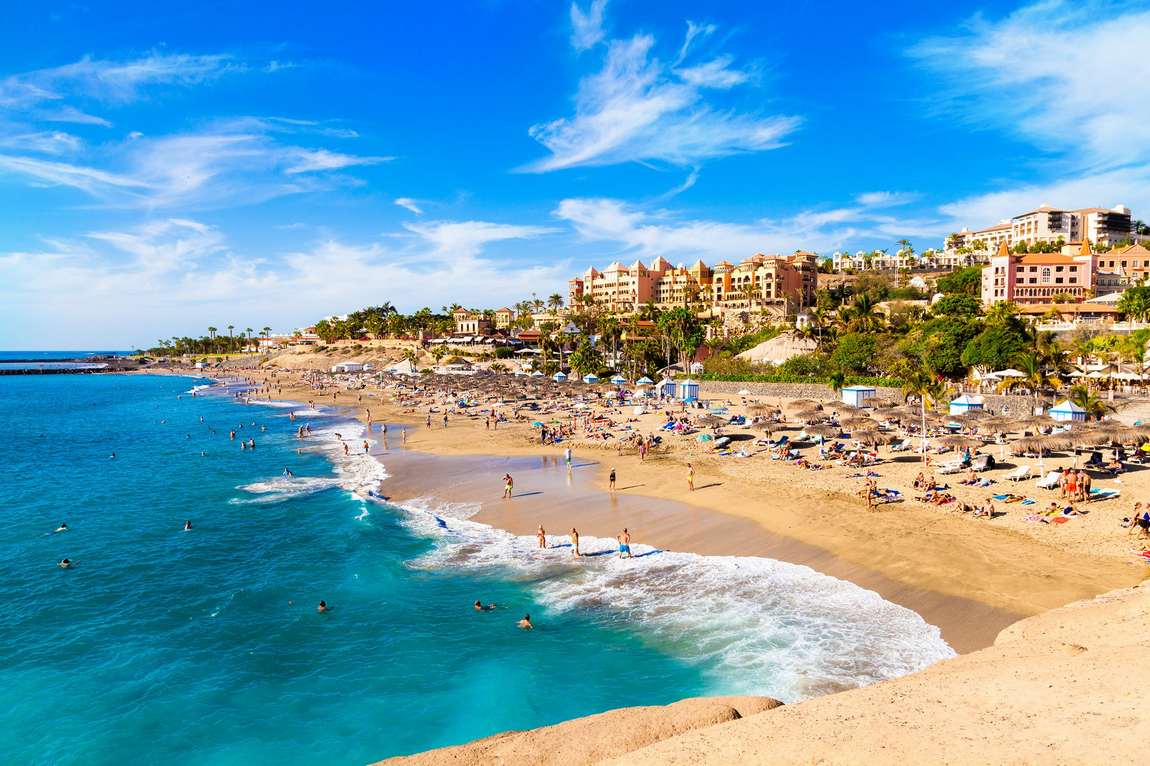Imagine: you've planned a holiday with the kids in Tenerife and decide to trace your travel itinerary on a map. You're pointing your finger at the countries of Europe, skirting the northwest coast of Africa and stopping at the southern borders of Morocco. Tiny dots in the Atlantic Ocean are the most exotic and the southernmost Spanish resort, the Canary Islands.
Tenerife's resorts can surprise even sophisticated tourists. Eternal spring instead of changing seasons, ocean instead of sea, black sand instead of golden sand — as they say, find ten differences. To save you the hassle, Kidpassage has already seen the critical differences between family holidays in Tenerife: find out when it's warmest and how to spend your time in Tenerife in a fun and enjoyable way.
Tenerife on the map of Spain
Tenerife is the largest of the Canary Islands. It is located in the Atlantic Ocean, 500km off the northwest coast of Africa and 1,300km from the Spanish mainland. The island's capital is Santa Cruz de Tenerife (more commonly called Santa Cruz for short).
Hot weather is customary in Tenerife's latitudes. But this doesn't apply to the Canary Islands. Tenerife has no seasons other than spring. When it's freezing in Europe in winter, the temperature in the Canaries is +20°C. And instead of the typical summer heat in southern Europe, the islands are pleasantly warm: +25°C to 27°C.
Tenerife for Kids

Tenerife's exoticism is appealing, but it's not the island's only advantage.
Tenerife's weather is reminiscent of a warm late spring, perfect for those who can't stand the heat. It is ideal for those who can't stand the heat.
Tenerife has a long beach season, peaking in September and October, which is another plus for children. However, the water in the Atlantic Ocean is rather chilly until autumn, so staying in resorts on the Spanish mainland during the summer is better.
And here is another feature of Tenerife that can seem both advantage and disadvantage. It's a boring place to stay with your child, travelling around the island to gain some experience. But if you do, you'll discover something new and enjoyable.
As for a holiday with an infant or toddler, all you need to do is find a family-run hotel and enjoy the comfort and peace of mind. The journey to Tenerife takes at least 7-10 hours. One of the island's few drawbacks is its remoteness.
Best time to travel
There are two answers to the question of when it's best to go to Tenerife, and both are correct. The timing depends on your goals. The first answer is between June and October. It is the warmest season in Tenerife when you can sunbathe and swim. That being said, summer and autumn are not so hot on the island that you have to give up on excursions.
Tenerife's open season starts in September, and the warming time of the ocean is in June or August.
The downside of this period is the huge amount of holidaymakers. You'll need to book your hotel accommodation a few months before and be prepared for a lack of beach space.
The answer to the second question is anytime. As it never gets cold and lousy weather, you can climb Mount Teide in winter and visit the mountain villages, where cave houses are still being built and kept according to the traditions of past centuries. Carnival takes place in winter, and the fun lasts almost a month in every town of Tenerife. Children take part in a mini carnival.
Weather and Climate

The scientific classification of Tenerife's climate is less eloquent than its poetic description: the Canaries have been called the islands of eternal spring. The average temperature is +21°C, slightly warmer in summer and autumn and somewhat cooler in winter. The island's area is relatively small, but the climate in the north and south is markedly different.
The northern coast is a little cooler, and it rains more often. Mountains protect the south coast from cold winds and rain, so it's warm and sunny.
Eternal Spring resembles summer in June when temperatures rise to +23-24°C. During July and August, thermometers reach +25-27°C, occasionally a little hotter. If you plan a summer holiday in Tenerife, choose June and July, as heavy downpours occur in August.
The sun is at its softest in September. During this time, you can spend considerably more time on the beach than during the summer: the air temperature stays between +23-25°C, and the sea is even warmer than in July and August. That's why September is considered the best holiday in Tenerife for children.
October is still quite warm, but the rains do come and go. Usually, the rain doesn't last for a few days but pours heavily for an hour or two before giving way again to clear weather.
From November to May, the island again enters 'spring' mode. Temperatures drop from +20°C to +16°C during the winter months, then rise again: the air warms to +17-18°C in March, +19°C in April and +20-21°C in May.
Rainfall is a rare occurrence in winter and spring. It's not a wrong time to be in Tenerife with a baby, although sunbathing and swimming in the sea is unlikely.
Warm days at any time of year are followed by relatively cool nights. Once it gets dark in Tenerife, temperatures drop to +13-14°C in winter and +17-20°C in summer. Clothes for the evenings, evening walks, excursions to the north and climbing Mount Teide are other things you'll need if you're travelling with your child.
Tenerife's climate is characterised by an occasional "hello from Africa" in the form of dust, sand and rising temperatures. This phenomenon, caused by the proximity of the Sahara Desert, can be a nuisance to tourists. But it only happens a few times a year, lasts 2-4 days and is far from uncomfortable.
Sea Temperature

Tenerife's water temperature changes very little throughout the year, as do the air temperatures. Unfortunately, the water is too cold for children most of the time due to the Canary Current.
During July and August, the water gets as warm as +22-23°C, and it's not until September that the sea reaches its maximum temperature of +24°C. The sea is still warm in October, with temperatures of 23°C for most of the month. The rest of the time, the water temperature on the island does not exceed 20°C.
And here's something else important: of all the resorts in Spain, the warmest sea in October is in the Canaries. When the beach season is closed almost everywhere else, it's still in full swing in Tenerife.
Food
Hotels in Tenerife use all dining concepts from breakfast only to all-inclusive. If you're going to eat in a hotel, ask about children's or dietary menus - it's not uncommon.
Still, most tourists prefer to eat in the restaurants outside the hotels. You'll find something to suit every palate in Tenerife, from Spanish to local.
Be sure to offer your child some Canarian fries, among other things. The ingenuous jacket potatoes, once cooked in seawater and now just very salty, are coated in salt crystals and therefore gain an unspeakable fascination in children's eyes. There are supermarkets and hypermarkets in all the popular resorts. Mostly Spanish chain Mercadona and SuperDino/HiperDino shops are only present in the Canaries.
Fresh fruit and vegetables, fish, and cheeses can be bought at farmers' markets. They are open once or twice a week: in Costa Adeje — on Thursdays and Saturdays and in Los Cristianos — on Sundays. The best fish market on the south coast is in Los Cristianos. Puerto de la Cruz has a food market on Wednesdays and Saturdays.
Getting Around

Titsa buses, also known as 'guagua', are Tenerife's only form of public transport. Around 200 routes are around the island, so that you can get almost anywhere.
The most popular routes for tourists are the 110 and 111, connecting Las Americas, Los Cristianos and Costa Adeje with Santa Cruz, and the 101-104 going to the capital from Puerto de la Cruz.
The fare depends on the distance. For example, a ticket from Costa Adeje to Los Cristianos will cost €2, and from Costa Adeje to Santa Cruz €9.50. Tickets for children cost the same as for adults.
The Bono-Via card is worth buying if you plan to take frequent transport to Tenerife. Every trip with a BonoVi card is considerably cheaper than buying single tickets. For example, a journey from Costa Adeje to Santa Cruz with Bono-Via would cost 6.25 Euros.
The Bono-Via card is also valid for the Santa Cruz tram. Single tickets can be bought from the driver, but the card can only be purchased at bus stations or special retail outlets. Buses generally run from 5:30-6:00 to 21:30-22:00. You can find exact timetables, intervals, ticket prices and other helpful information on the bus companies' websites.
Renting a car to get around Tenerife is a smart decision: it's easier to reach the untouristy and stunningly beautiful places by car than by bus. The average fare is about €1 per kilometre, and a further €2-2.50 to be paid for boarding. Taxis — white cars with a green fare display — can be found at taxi stands or by phone.
The roads in the countryside are less congested than those in the city. In the resorts, traffic problems and finding parking spaces can occur. The island has few free parking areas, mainly near tourist attractions. Paid parking on the streets is marked with a blue line. Underground car parks can also be used.
 [email protected]
[email protected]






.jpg)

.jpg)
.jpg)

.jpg)










